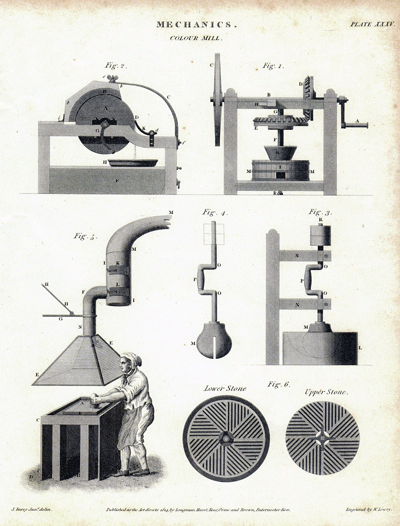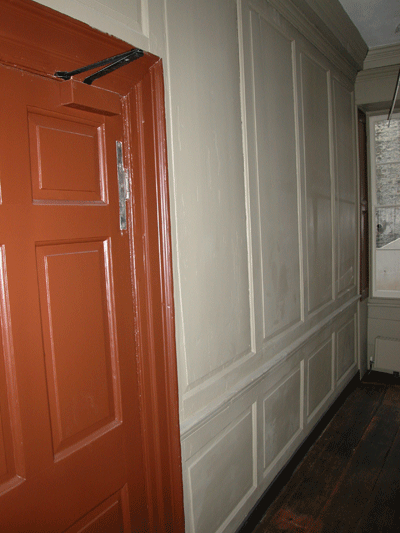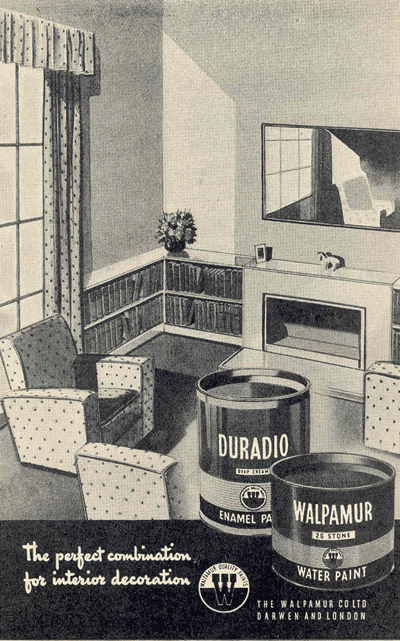The history of paint and the birth of DIY
Patrick Baty of Papers and Paints explains the history of how paint developed from mediaeval times

The walls of English mediaeval houses were decorated in one of a few ways: plastered with the bare surfaces white or colour-washed; or covered over with tapestry or painted cloths; or panelled with oak.
Limewash - produced by heating lump lime and then slaking in water - or a chalk and water mixture sometimes bound with glue, would have been used on the plaster. When tinted, naturally-occurring coloured earths or chalk tinged by berries from the Buckthorn family for example, were used to give colour. As the nature of construction changed, unsophisticated limewash was used less frequently except for 'common purposes'.
In English homes, the grain and colour of oak was much admired and it was often left uncovered, merely being given a sealing coat of varnish. Other, more expensive woods, such as cedar and walnut were also used, but this depended on the wealth of the householder - wood was viewed as a beautiful and precious commodity. With the scarcity of native oak, caused largely by ship and house building, it became more common and fashionable to imitate the expensive woods with paint or to use an opaque coating. Certainly on external woodwork it was essential to apply a covering of paint to protect it from the weather.
Until recently the word ‘paint' signified an oil-based medium prepared with white lead, pigment, linseed oil, and turpentine with the finish or degree of sheen regulated by the ratio of the two latter components. If a higher gloss was desired, varnish was applied.

Early 19th century Colour Mills
The process of grinding pigments is a labour-intensive operation, some types requiring a lot of work to ensure their complete dispersion in oil. The introduction of horse-powered mills in the early eighteenth century enabled the colour shops to supply finely ground pigments at a reasonable cost and in a convenient form. Pigments, in paste form, were sold in animal bladders which were pierced with a tack in order to squeeze out the colour. This was added to white lead paint until the desired shade was obtained. One effect of this labour-saving innovation was to begin to take business out of the hands of the trained painter and put it into those of the amateur. By 1734, as a result of this new business ‘several Noblemen and Gentlemen have by themselves and Servants painted whole Houses without the Assistance or Direction of a Painter'. DIY had been born.
Though it may seem surprising, a glossy finish was considered ‘much more beautiful and lustrous' on panelled walls and woodwork until at least the mid-eighteenth century. It offered a greater degree of protection and also better light reflectivity than a matt surface, perfect for rooms lit by candlelight. Recent analysis of the paint on the walls of Benjamin Franklin's house in Craven Street identified a superficial coat of glaze on the panelling. However, with the introduction of plaster walls in place of panelling, a flat finish became fashionable ‘for all superior work'. This process of 'flatting' was more expensive as it involved an extra operation and was too fragile for external areas of those receiving heavy wear.
Sign up for the Country Life Newsletter
Exquisite houses, the beauty of Nature, and how to get the most from your life, straight to your inbox.

Benjamin Franklin House
Instead, a more common method of painting plaster was to apply a coat of soft distemper - essentially a mix of powdered chalk, glue size and water, with pigments added to taste (see earlier blog on choosing paint for historic buildings). This produced a very matt surface but it too was fragile and could only be used on interior plasterwork. An unbound version - literally chalk and water - was often employed to whiten ceilings.
Distemper was cheap and relatively easy to apply, but had an even greater advantage over an oil-based paint: its permeability to moisture. With freshly-applied lime plaster containing nearly half a gallon in each of its three coats per square yard, a new building would have a large amount of water present in it. Most of this would slowly evaporate during the first few years and this would only cause problems if prevented from doing so by an impervious coating of paint.

Walpamur Water Paint
The repainting of a distempered surface entailed complete removal and washing down of the previous finish. Although troublesome, this did have the advantage of not clogging up the detail of decorative plasterwork. However, its fragility on surfaces within reach led to a number of ‘improved' recipes for water-based paints appearing throughout the nineteenth century. Adhesives or oil were combined in order to make them more durable, the latter being the first true 'emulsion' paints, although it was to be many years before the modern stable vinyl and acrylic emulsions were developed.
Patrick Baty is a consultant on historic paint and colour. He also has a shop in London, Papers and Paints, where you can not only get expert advice, but they will mix authentic and any number of other colours. Papers and Paints will be 50 years old in September.

* Follow Projectbook on Twitter
Country Life is unlike any other magazine: the only glossy weekly on the newsstand and the only magazine that has been guest-edited by HRH The King not once, but twice. It is a celebration of modern rural life and all its diverse joys and pleasures — that was first published in Queen Victoria's Diamond Jubilee year. Our eclectic mixture of witty and informative content — from the most up-to-date property news and commentary and a coveted glimpse inside some of the UK's best houses and gardens, to gardening, the arts and interior design, written by experts in their field — still cannot be found in print or online, anywhere else.
-
 ‘It had the air of an ex-rental, and that’s putting it politely’: How an antique dealer transformed a run-down Georgian house in Chatham Dockyards
‘It had the air of an ex-rental, and that’s putting it politely’: How an antique dealer transformed a run-down Georgian house in Chatham DockyardsAn antique dealer with an eye for colour has rescued an 18th-century house from years of neglect with the help of the team at Mylands.
By Arabella Youens
-
 A home cinema, tasteful interiors and 65 acres of private parkland hidden in an unassuming lodge in Kent
A home cinema, tasteful interiors and 65 acres of private parkland hidden in an unassuming lodge in KentNorth Lodge near Tonbridge may seem relatively simple, but there is a lot more than what meets the eye.
By James Fisher